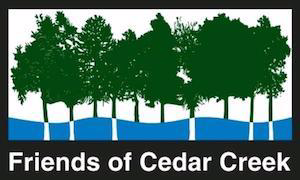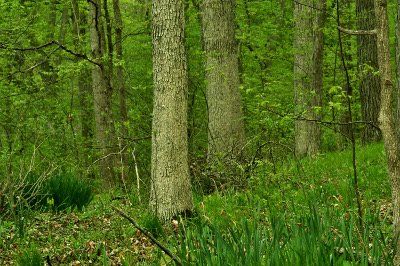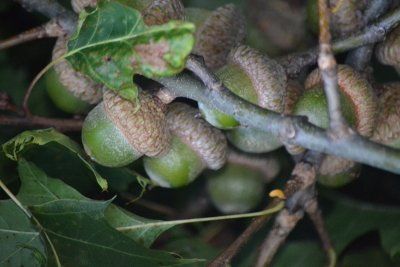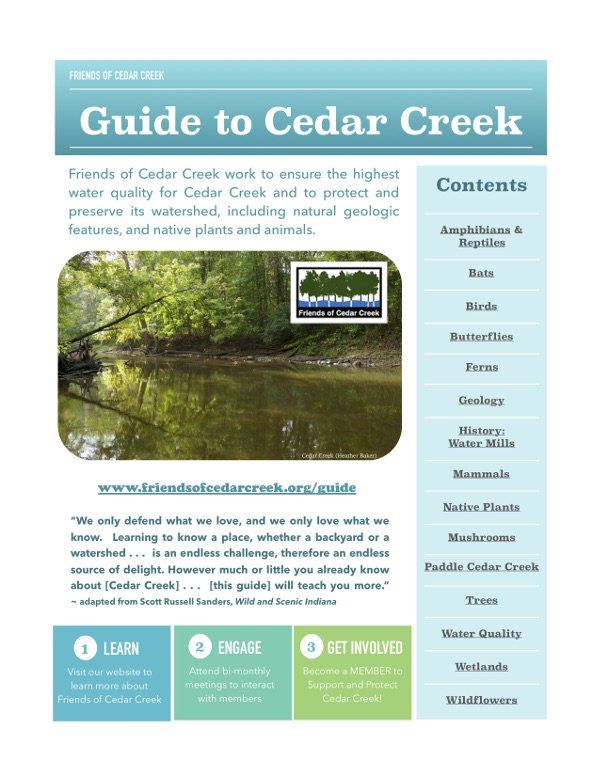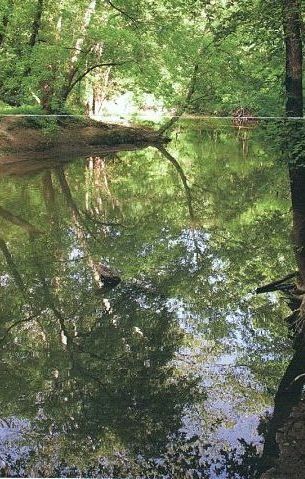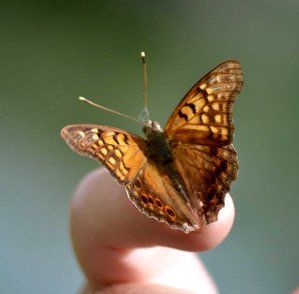Guide to Cedar Creek
Tremendous TreesHeather Baker
“Biologists have calculated that around 1800, before white settlement began in earnest, 20 million of Indiana’s 23 million acres were covered with trees, amounting to more than 80% of the state . . . . one of the greatest stands of hardwoods anywhere on earth. Dominated by oak, hickory, maple and beech, the forest harbored more than a hundred species of trees . . . . Today, according to biologists, less than 1% of the state remains in a high-quality natural condition” (Scott Russell Sanders, Wild and Scenic Indiana, 2005).
In today’s Cedar Creek watershed, hardwoods include some old-growth trees long nourished by nutrient-rich soil in the creek’s floodplain and wetlands. Mixed native hardwoods grow on the creek bank’s calcareous slopes. All feed Cedar Creek’s natural ecosystem through leaf fall and other nutrient cycles, and they sustain the corridor’s diverse wildlife. Some of my favorite native species are shagbark hickory, flowering dogwood, sugar maple, white oak, eastern cottonwood, and the American sycamore.
I like looking for shagbark hickory
on the upper moraine trails near Cedar Creek. It’s easy to identify by the curled edges of thin gray bark draped from its two-to-three- foot-diameter trunk. Some shagbarks grow a hundred feet tall. While most prefer drier sloped areas, some grow in wet soils. This unisex tree provides unique opportunities for self pollination with the male flower’s long, green, pod-like blooms, and the female flower’s small, green, upward-turned, bell-shaped blossoms. The resulting large, fuzzy green fruit breaks apart into four pieces to expose an edible nut.
Flowering dogwood,
found in shady areas of the forest, blossoms with white flowers in April and May when many trees are still budding. The white/pink edges of the bract are sometimes mistaken as the flower petals, but the flowering section is actually the yellow cluster in the center. The dogwood has simple, dark green leaves with smooth edges that turn reddish-purple in autumn. Brown-gray scales distinguish its hard durable bark from other tree species. Flowering dogwood usually grow between 20 and 30 feet tall. Birds and squirrels feast on their drupes, the trees’ football-shaped fruit abundant in September and October. Natives used both bark and roots for medicinal remedies.
In autumn, red, orange and yellow hues scatter across the Cedar Creek landscape--a breathtaking beauty that is just one of the sugar maple’s
contributions. Another is its rich sugary sap that flows in early spring. (Did you know it takes nearly 40 gallons of sap to make just one gallon of maple syrup?!) Like the sycamore, the sugar maple relies on rich, moist soil. The sugar maple’s leaves decompose faster than other species’ leaves, making it a wonderful organic fertilizer for the forest floor. It has gray scaly bark with irregular patterns, and its lush, oval, crown-shape canopy provides shade. Finally (as if its beauty and usefulness weren’t enough), its helicopter-shaped seeds are encased in winged capsules to be dispersed by the wind. And it’s fun to watch them. Perfect.
The white oak
has an expansive root base, strong limbs, and a broad and rounded canopy of somewhat hairy, round-lobed leaves alternately arranged. Its mossy green maturing acorns turn tawny brown when ripe. I always hope to glimpse fox squirrels frolicing, looking for these acorns under leaf-fall when I hike in the Cedar Creek area in autumn. The oak’s light gray-white bark has vertical rounded scales that are shed in spring with new growth.This process strengthens the trunk’s girth to a maximum of four feet in diameter. While not the tallest tree in the forest, the white oak can grow 50 to 70 feet, providing habitat for numerous species of birds and other woodland creatures. The white oak is important to the Cedar Creek ecosystem for both its beauty and its multiple contributions to the survival of wildlife and the health of the water and soil.
Eastern cottonwood
trees scatter their seeds across Cedar Creek’s wet soils and banks in white, cotton-like filament that floats in early summer breezes and clings to shorelines and vegetation. Each year the fast-growing cottonwoods can grow up to five feet in height and an inch in diameter. Their leaves are similar to the triangular leaves of a sycamore: thick, waxy, coarsely toothed, rounded yet coming to a single point, and alternately arranged on the twigs. Long, ribbon-like yellow flowers produce red catkin clusters that drape on bright green spring foliage. I fondly recall when, as a child, I gathered these seed clusters to pick apart and scatter in the wind, like the seeds of a dandelion. Now I am in awe as blankets of cottonwood seeds float through the calm waters of Cedar Creek, collecting debris and minuscule aquatic lifeforms as they travel. Although seldom used today for lumber, pioneers used cottonwood to build cabins and barns because it could withstand summer’s intense heat and winter’s harsh cold.
In the branches of towering, majestic Sycamore
trees high over Cedar Creek, Great Blue Herons have built a heronry--nests where they raise their young. The water diverts around the herons’ island-like refuge, and the ground beneath is usually littered with the sycamores’ distinctly shaped leaves. Their equally distinctive sycamore bark flakes off in puzzle-like pieces. On the trunk’s upper portions, the bark looks like it’s been camouflage spray painted in green and white hues, while the trunk’s lower new growth is medium to dark brown. Sycamores grow in Cedar Creek’s bottom lands near other trees that also usually require rich moist soil because they mature quickly. Considered one of North America’s tallest trees (50 - 130 feet), the sycamore also has a larger diameter than many other Indiana trees. And like other native plants, it helps sustain wild creatures: its decaying hollow cavities provide shelter for raccoons, opossum and wood ducks.
These are only six of at least 140 native tree species creating Cedar Creek’s diverse bioregion, all richly benefiting the corridor’s ecology. Native trees cleanse the air. They contribute to the soil nutrient cycle. Of great importance are their strong roots that help keep creek erosion to a minimum.
Without these crucial, nutrient-rich, soil-and-tree-root relationships, Cedar Creek would not be as healthy and self sustaining as it is today. You can help sustain this magnificent forested landscape by planting [and not cutting down] these and other native trees.
More to Explore . . .
- ACRES, Inc. Tom and Jane Dustin nature preserve management plan, p. 24-25, 2012.
- Arbor Day Foundation
- What Tree Is That? https://www.arborday.org/trees/whattree/whatTree.cfm?ItemID=E6A.
- A Field Guide to Eastern Trees, Peterson Field Guide Series, G. Petrides, Houghton Mifflin, 1988.
- Backyard Tree Identification Guide, HomeAdvisor, 1999-2018.
- Fifty trees of Indiana, T.E. Shaw, Division of Forestry, Department of Natural Resources, Indiana and Department of Forestry and Conservation, Purdue University, 1981.
- Leaf-ID - Easy Tree Identification. http://www.leaf-id.com.
- TreeBarkID.com
- Winter Tree Identification. http://treebarkid.com/index.php/general-bark-id-key.
- Trees. The Nature Library, JE. Rogers, Doubleday, Page & Co., 1926.
- Trees - Fandex Family Field Guides, S. Aronson, Workman Publishing, 1997.
- The Tree Book for Kids and Their Grown-ups, G. Ingoglia, Brooklyn Botanic Garden, Inc., 2008.
- Trees of Indiana Field Guide, S. Tekiela, Adventure Publications, Inc., 2006.
- 101 Trees of Indiana, M. Jackson, Indiana University Press, 2003.
- Tree Rings and the Life of a Tree, Ava Flowers
Trees Image Information
Trees at Dustin Nature Preserve
(Heather Baker)
Shagbark Hickory
(Heather Baker)
Dogwood blossoms
(Carol Roberts)
